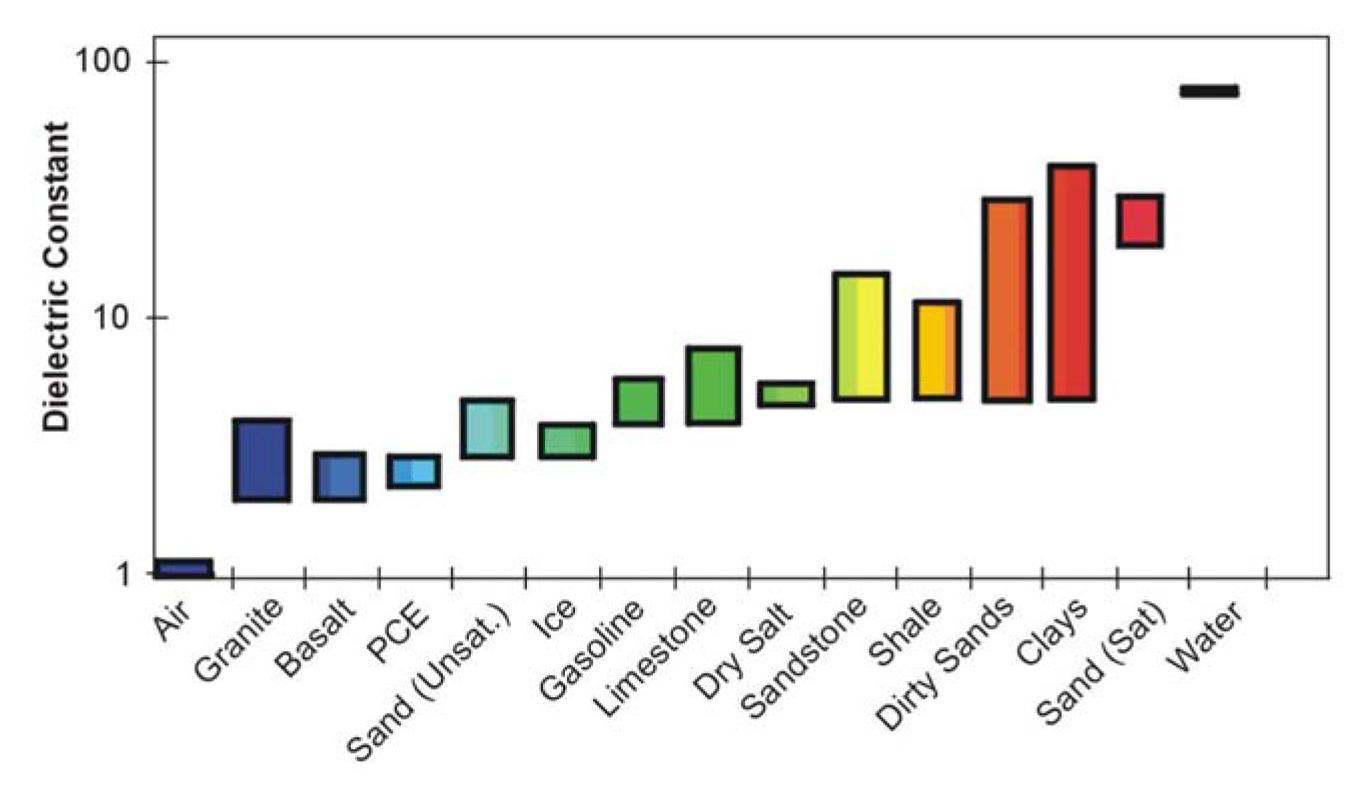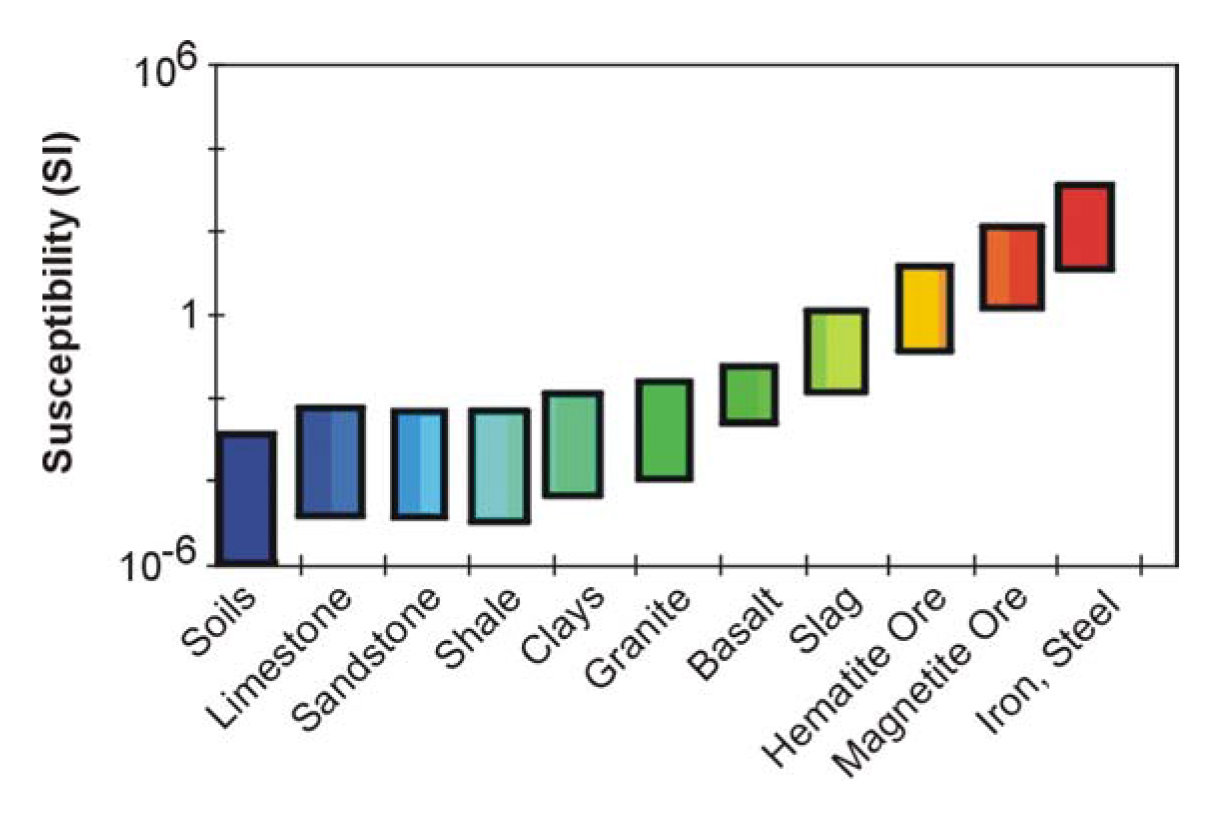Magnetic susceptibility is a measure of the ability of a material to be magnetized. The proportional constant links magnetization to the applied magnetic field intensity (at levels below which saturation and hysteresis are important). Magnetic susceptibility, k, is related to magnetic permeability (μ) by:
 (28)
(28)
where μ0 is the magnetic permeability of free space, which is 4π.10-7. The most magnetically susceptible materials are called ferromagnetic materials which contain iron, nickel, cobalt and many alloys of these materials. Of the several ferromagnetic minerals, magnetite predominates in the applications addressed here. In waste sites, iron and steel are the major sources of magnetic anomalies. Figure 235 shows the range of the dielectric constant for different geologic materials including air (dielectric constant = 1) and water (dielectric constant = 80).

Figure 235. Dielectric constant range for some common materials.
There are several other magnetic quantities, and their relationship is sometimes confusing. The basic magnetic object is the magnetic pole, equivalent to the north end of a magnet. Magnetic poles (a) do not exist as discrete particles, and (b) always appear to come in pairs, and are, therefore, a dipole. A dipole is the result of electric ge in motion; one is made by passing a current I (amperes) around a circuit of area A (meters). Hence, the dipole strength or magnetic dipole moment, M is a vector perpendicular to the plane of that coil with units of ampere-meter2.
All matter consists of ge in motion, but for most materials, the resulting dipoles are randomly aligned and cancel. For certain materials, this cancellation is incomplete, and they become magnetic. Magnetization, J, is the density of aligned dipoles per cubic meter, with units (ampere/m).
The earth's geomagnetic field, B, is the origin of most of the magnetization, J, found in rocks, that is, the magnetization is induced by the present Earth's magnetic field. The relationship is:
 (29)
(29)
The exceptions are materials that have a permanent or remnant magnetization, acquired elsewhere in a strong local magnetic field.
We detect magnetic objects in the subsurface by the way their magnetic fields distort the earth's geomagnetic field. These distortions are termed anomalies. It is generally safe to assume that sediments are non-magnetic. Igneous or metamorphic rocks can have appreciable and locally variable susceptibility.
The magnetic moment M of an object, assuming it is uniformly magnetized, can be estimated as:
 (30)
(30)
where V is the volume of the object.
The unit of magnetic susceptibility, k, in the SI system is dimensionless. Magnetic permeability (μ) has units of Henrys per meter. The geomagnetic field (B) has units of force per magnetic pole or Teslas. The practical unit of geomagnetism is the nano-Tesla, or gamma.
Geomagnetic Field
The geomagnetic field of the earth is very similar to that of a large bar magnet placed at the center of the Earth, with its south end oriented toward the north magnetic pole. The field is dipolar, vertically downward at the north magnetic pole, vertically upward at the south magnetic pole, and horizontal at the (magnetic) equator. It has a strength of roughly 30,000 gammas at the equator, 70,000 gammas at the poles. In the United States, it is acceptable for the purposes of simple modeling to assume that a field declination of about 60 degrees has a strength of 55,000 gammas.
Susceptibility and Magnetite
The susceptibility of most rocks can be related to magnetite content reasonably well as follows:
 (31)
(31)

Figure 236. Susceptibility as a function of magnetite content.
where f is the volume percent of magnetite (Grant and West, 1965). A plot of this empirical relationship is shown in figure 236.
Magnetization of Soils
Breiner (1973) points out that soils reflect their parentage, and that some, as a result, will be considerably more magnetic than others. Because magnetite tends to concentrate in sediments where streams carrying heavy metals lose velocity, concentrations can be expected in distributing streams, in alluvial fans, in glaciated terrain (particularly eskers, outwash, and beach deposits). In highly organic soils, maghemite, a relatively magnetic form of hematite, can be produced. As a result, the magnetic susceptibility of soils can be laterally variable and, because they are close to the magnetometer, give rise to very localized anomalies of significant magnitude. Figure 237 presents the susceptibility range of common materials.

Figure 237. Susceptibility range of common materials.